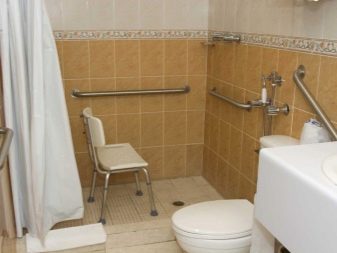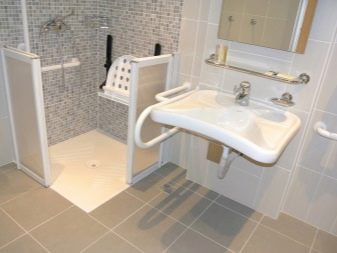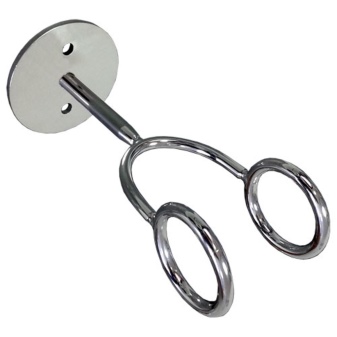Recommendations for choosing handrails for disabled people in the bathroom and toilet

Such socially vulnerable categories of the population as the elderly and disabled people need special care. Special conditions must be created for them, not only socially, but also in everyday life. Sometimes even the most familiar everyday procedures become a real challenge for them: getting out of bed, washing, getting dressed, going out into the street. Modern society strives to embody the concept of independent life and equality of all social strata. Old age and disability should not be an obstacle for a person on the way to normal life. For this, special rehabilitation means and adaptations for adaptation are created and widely used, which, in particular, include handrails for disabled people in the bathroom and toilet.

Advantages and disadvantages
Today, all institutions of the social sphere, health care, state and private boarding houses, boarding houses, sanatoriums must be equipped with handrails. Large shopping centers are equipped with special toilets for people with disabilities and other low-mobility categories of citizens. All entrances in new buildings are equipped with handrails and ramps, which are convenient to use not only for the elderly and disabled, but also for mothers with strollers and preschool children. Increasingly, handrails are installed in the bathrooms of apartments where the elderly, the disabled, people of all ages live in the difficult postoperative period, for whom care and personal hygiene are especially important.


Among the advantages of this type of device, it is necessary to highlight:
- Ease of use - no complicated bulky structures;
- Independence - thanks to handrails and other special devices for the bathroom and toilet, the elderly and the disabled can do without outside help;
- Reliability - handrails are firmly mounted to the wall or floor and can withstand a load of up to 150 kg;


- Versatility of design - the modern market of rehabilitation means offers handrails for right-handers and left-handers, made of a variety of materials, at affordable prices;
- Durability - steel handrails do not rust, do not crack, are susceptible to any stress and water impact, which allows them to be used as long as possible.


Speaking of the shortcomings, a certain degree of installation complexity can be distinguished.
It is recommended to entrust the installation of handrails to professionals, because there are special rules and regulations for the installation of these structures, depending on the model and purpose:
- height from the floor;
- distance from the wall;
- angle of inclination and so on.



And also of the minuses it is worth noting the following. Despite the ergonomic design and variety of finishes, handrails in the bathroom and other non-specialized areas do not always fit well into the interior. Oftentimes, the installation of handrails is a forced measure, rather than a design element.


Types and characteristics of structures
Depending on the purpose, handrails can be divided into several types.

Stationary
This type of structure includes wall-mounted straight or angled handrails. They are installed above the bathroom, as well as in the case when a person with a disability or an elderly person is overweight.Stationary floor structures are installed only in a fairly large bathroom area.



Folding and swivel
Such handrails are used, on the contrary, in small-sized rooms, allowing the disabled person to move freely, tilting the handrails against the wall or lowering them when necessary. As a rule, they are installed next to the toilet, allowing a person in a wheelchair or with problems of the musculoskeletal system to access the toilet. For convenience, folding handrails can be equipped with a hook for toilet paper, and swivel ones are additionally equipped with a soap dish.
The advantage of this type of handrail is the possibility of unhindered access to sanitary and household appliances, ease of cleaning the room.


Steps
Special handrails-steps are an indispensable attribute in the bathroom for the elderly. With age, immersing yourself in a bath becomes a real problem, especially if for health reasons there are problems with joints, coordination and orientation in space. It is also relevant for people with limited movement after a hip fracture. A special step allows you to get in and out of the bath without much physical exertion. The step can be single, double, or complete with an additional support element - a handle.
The two-stage design is taller and more stable, but also weighs more than the single-stage design.

On suction cups
This type of handrail is most often made of plastic, it is distinguished by its lightness of design and mobility - the handrail can be installed in a new place every time, where necessary, and removed at the end of water procedures, which does not burden the interior of the bathroom. However, the disadvantage of such models is the lack of reliability: the handrail on the vacuum suction cups can slip if the mounting surface is soapy, or even come off the high load. Even the highest quality materials of handrails on suction cups cause psychological fear of use in older people.
The suction cups themselves wear out quickly and have to be changed quite often.


Rigid fixation
These handrails are similar to stationary ones, but they are particularly durable due to double fixation: to the wall and to the floor at the same time. This achieves maximum reliability. This is especially true for people with a lot of weight. Rigid handrails can be installed both along the wall and perpendicular to it (for example, near the toilet), which significantly reduces the free square meters of the room.

Primary requirements
There is a special normative legal act - Code of Rules No. 59.13330.2012 “Accessibility of buildings and structures for people with limited mobility”. This document outlines the basic requirements for special equipment that provides disabled people with unhindered access to premises for various purposes.
If there is a need to equip a bathroom or toilet with special handrails, you need to seek professional help.


Mistakes during installation can lead to injury, so the issue of savings is inappropriate here. When choosing a suitable design, you should also consult a specialist. In the case when it is necessary to equip a bathroom with handrails in a public building (shopping and entertainment center, health care institution), they call special teams of builders and assemblers who will install the handrails as soon as possible in accordance with all regulatory requirements. This is especially important, because before putting the object into operation, it is accepted by a special expert commission. In case of non-compliance with SNiPs, a permit to put the building into operation will simply not be issued.


When installing handrails for private use, you can do it yourself, but first you need to carefully study the necessary installation requirements.As a rule, in specialized stores, complete with handrails are all the necessary fastening elements, accessories and instructions for assembly and installation. Brackets, hinges and decorative plugs are also included, but in rare cases they need to be purchased separately. The installation of handrails at home should correspond to the individual characteristics of an elderly person or a disabled person: his height, weight, physique features. Some diseases lead to impaired motor function of the limbs (Parkinson's disease, strokes, paralysis), therefore, when installing handrails, you should focus on the working hand.

Popular materials
The most popular handrail materials are several.
- Steel - the most durable material, provides maximum reliability of stationary structures. Steel handrails can be additionally coated with enamel, which gives them a more aesthetic appearance, and they fit perfectly into the design of the bathroom. Stainless steel perfectly tolerates care with any disinfectant.

- Brass - a very strong alloy capable of withstanding a load of up to 160 kg. Differs in high structural strength. And also brass has anti-corrosion properties.
- Chromium - safer material, its surface prevents slipping when used in rooms with high humidity.
- Reinforced impact resistant plastic used to create small wall structures.



Features of fixtures for different rooms
In the bathroom, for additional safety, special devices can be used: handles on suction cups that are attached directly to the walls of the bath, an anti-slip rug is laid on the bottom, special benches or swivel chairs are used to facilitate the transfer from the bath to the chair.
To ensure the approach and immersion in the bath, mobile, mobile steps are often used. The structure is quite stable and can withstand a lot of weight, making it easy to use by older people who are afraid of falling.



There are special illuminated mirrors with a rotary handle for the convenience of wheelchair users. This design allows you to tilt the mirror at the desired angle.
In case of hip fractures, the elderly are forbidden to sit down deeply, therefore, if the toilet is too low, a special nozzle is installed on it, due to which the load on the hip joint is reduced, and the handrails on both sides help to get up safely.

There are even special hooks for crutches, which are installed in the toilet. They are used to hang crutches and walking sticks at a convenient height so that they do not fall or fall over the toilet or sink.


Safety recommendations
In the toilet, the handrail is mounted to the load-bearing wall. If there is none, and a plasterboard partition replaces it, an additional tab should be made that can withstand a load of more than 100 kg. If possible, handrails should be mounted on both sides of the toilet, which will allow the disabled person to independently transfer to it and get up safely.

In the bathroom, the handrail is mounted along the wall to which the bathtub adjoins. It is recommended to use materials with a chrome-plated finish to ensure non-slip. Bath handrails can additionally be rubberized or have a special thread on their surface. When choosing a suitable design, this should be taken into account for safe operation.
Sink handrails are usually installed around the entire perimeter, completely skirting the plumbing.

Thanks to this installation, the approach to the sink will be provided from any angle. The washbasin handrail should protrude no more than 10 cm. This distance is necessary for free grip and there will be no need to reach for the washbasin.

Experts give several tips and tricks for comfortable bathroom equipment:
- when choosing a suitable design, you should focus on the dimensions of the room;
- the doors to the bathroom should open outward, and the threshold should be minimally low or completely absent;
- do not skimp on additional accessories (hook for toilet paper, towel holder, built-in soap dish), they increase the price of the structure, but bring maximum comfort;
- switches and door handles must be at an acceptable height for a person in a wheelchair to reach them easily.



Thus, the healthcare industry today aims to provide maximum comfort for people with disabilities.


Special devices and means of rehabilitation help to make their life as independent and fulfilling as possible. Handrails and other household appliances make it easier to care for elderly relatives and people with disabilities, improving their quality of life.


For a video review of Mobeli handrails for disabled people, see the following video.













The comment was sent successfully.